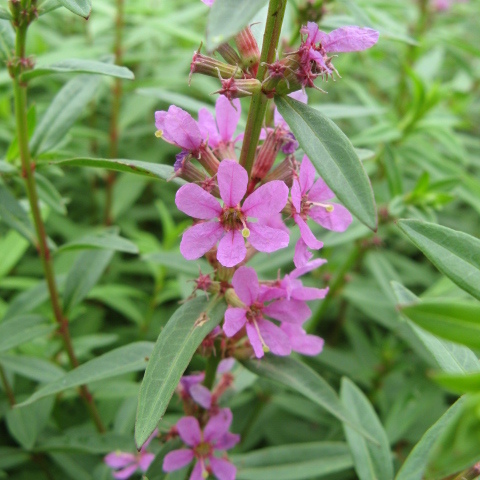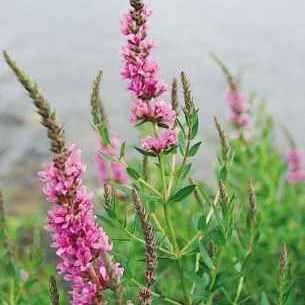Annual or perennial herbs, subshrubs, shrubs or trees. Leaves simple, opposite or verticillate, rarely alternate; stipules absent or minute. Flowers regular or slightly irregular, hermaphrodite, (3–)4, 6, 8(–16)-merous, solitary to paniculate, sometimes di-or tri-morphic. Sepals united into a tube (hypanthium), lobes valvate, often with small appendages between. Petals free, inserted towards the top of the calyx-tube, alternating with the sepals, folded in bud, or absent. Stamens usually 4 or 8, less often many (10–200) or fewer (1–2), inserted below the petals; filaments sometimes of different lengths in the different forms of flower, usually inflexed in bud; anthers 2-thecous, opening lengthwise. Ovary superior (except Punica), sessile or shortly stipitate, completely or incompletely 2–6-locular, rarely unilocular or multilocular (>i>Punica); style simple, sometimes of different lengths in different forms of flower; stigma often ± capitate; ovules 2–numerous on axile placentas sometimes not reaching apex of ovary (parietal in one >i>Ammannia). Fruit capsular or baccate, opening by a transverse slit or valves or bursting irregularly or ± indehiscent. Seeds numerous, without endosperm
Herbs, shrubs or trees. Leaves opposite or whorled, rarely alternate, simple, usually entire; stipules vestigial or absent. Inflorescences various from solitary to racemose spikes or cymose panicles. Flowers usually 4-, 6-or 8-merous, sometimes 3-or 5-merous, bisexual, regular or irregular, perigynous, sometimes heterostylous. Hypanthium prominent, often prominently nerved, sometimes spurred; appendages (epicalyx) present or absent. Sepals valvate, often alternating with epicalyx. Petals alternate with sepals, distinct, rarely absent. Stamens usually in 2 whorls and twice the number of sepals or petals, sometimes in 1 whorl equal to, or less than, the number of sepals or petals; anthers versatile, dorsifixed or basifixed. Nectariferous disc sometimes present. Ovary superior, semi-inferior or rarely inferior; carpels 2–6 (–many), fused; locules equal to number of carpels; placentation axile; style simple. Fruit usually a capsule, enclosed by persistent calyx, dehiscing variously, or a berry. Seeds with little or no endosperm.
Stamens numerous (32–200) in the primitive woody genera, often as many as the calyx-lobes, sometimes fewer (2 or 1) in the more advanced herbaceous ones, equal or sometimes very unequal (in heterostylous plants), inserted on the calyx-tube; filaments free; anthers 2-locular, bent inwards in the bud, dorsifixed and versatile, rarely basifixed (Pleurophora and Crimea, not from FZ area), dehiscing by longitudinal slits
Ovary usually free, sessile or stipitate, 2–6-locular or 1-locular (Cryptotheca); placentation axile, rarely basal, sometimes the central axis not reaching to the top of the ovary; style absent, short or elongate and flexuous; stigma capitate or punctiform, rarely 2-lobed; ovules numerous to 2, small, anatropous, ascending
Ovary superior, sessile or shortly stipitate, completely or incompletely 2–6-celled (rarely 1-celled); style simple, variable in length; ovules numerous, on an axile placenta sometimes not extending to the top of the ovary
Fruit mostly a capsule included in the calyx-tube or ± exserted, indehiscent or opening loculicidally or septicidally by valves or by a transverse lid or irregularly, with the placentas forming a central column
Petals inserted in the calyx-tube, as many as and alternating with the calyx-lobes, sometimes few or 0, often clawed, membranous, corrugated and imbricate in the bud, equal or sometimes unequal
Leaves simple, entire, 1-nerved or ± distinctly penninerved, decussate, sometimes verticillate, rarely alternate; stipules 0 or 2–10 or more, small, subulate, axillary
Stamens usually 4 or 8, or rarely more, inserted below the petals; filaments usually inflexed in bud; anthers 2-celled, opening lengthwise
Seeds 2-numerous, various in form, small, sometimes winged; embryo straight, with endosperm; cotyledons flat or rarely convolute
Calyx persistent, tubular, urceolate or campanulate, the lobes alternating often with ± developed appendages in the sinuses
Inflorescence various from single axillary flowers to fasciculate, cymose or paniculate; pedicels usually bracteolate
Flowers bisexual, actinomorphic or very rarely zygo-morphic, (3)4–5(6–16)-merous, homomorphic or often di-trimorphic
Herbs, shrubs or trees; leaves opposite or verticillate, rarely alternate; stipules absent or very small
Annual or perennial (sometimes marshy or aquatic) herbs, suffrutices, shrublets, shrubs or trees
Petals present or absent, inserted towards the top of the calyx-tube, crumpled in the bud
Fruit usually capsular, opening by a transverse slit, by valves, or irregularly
Sepals united into a tube, valvate, sometimes with appendages between the lobes
Flowers usually actinomorphic, hermaphrodite, solitary to paniculate
Seeds numerous, without endosperm; embryo straight
Disk absent or very small, cupular or unilateral


